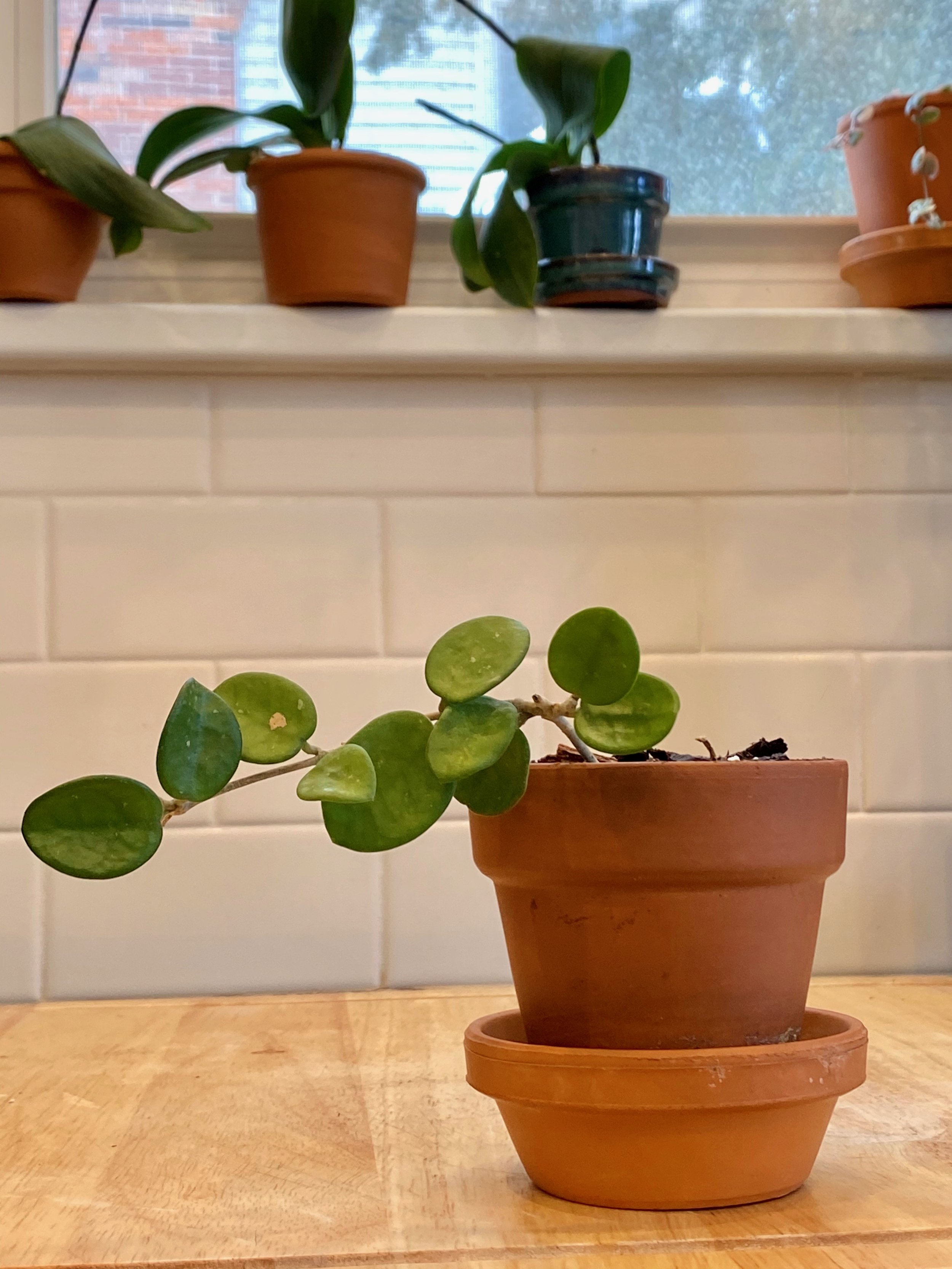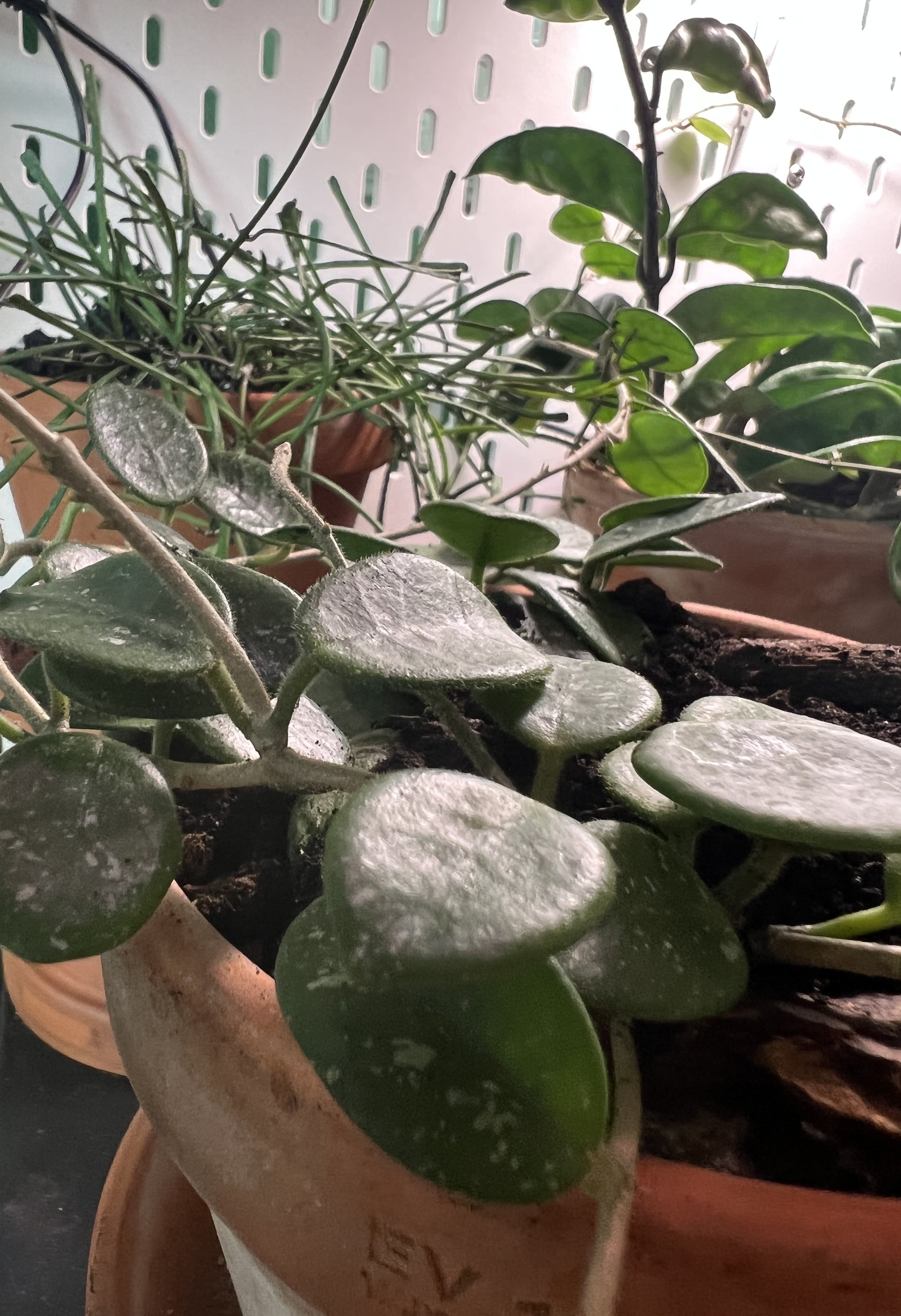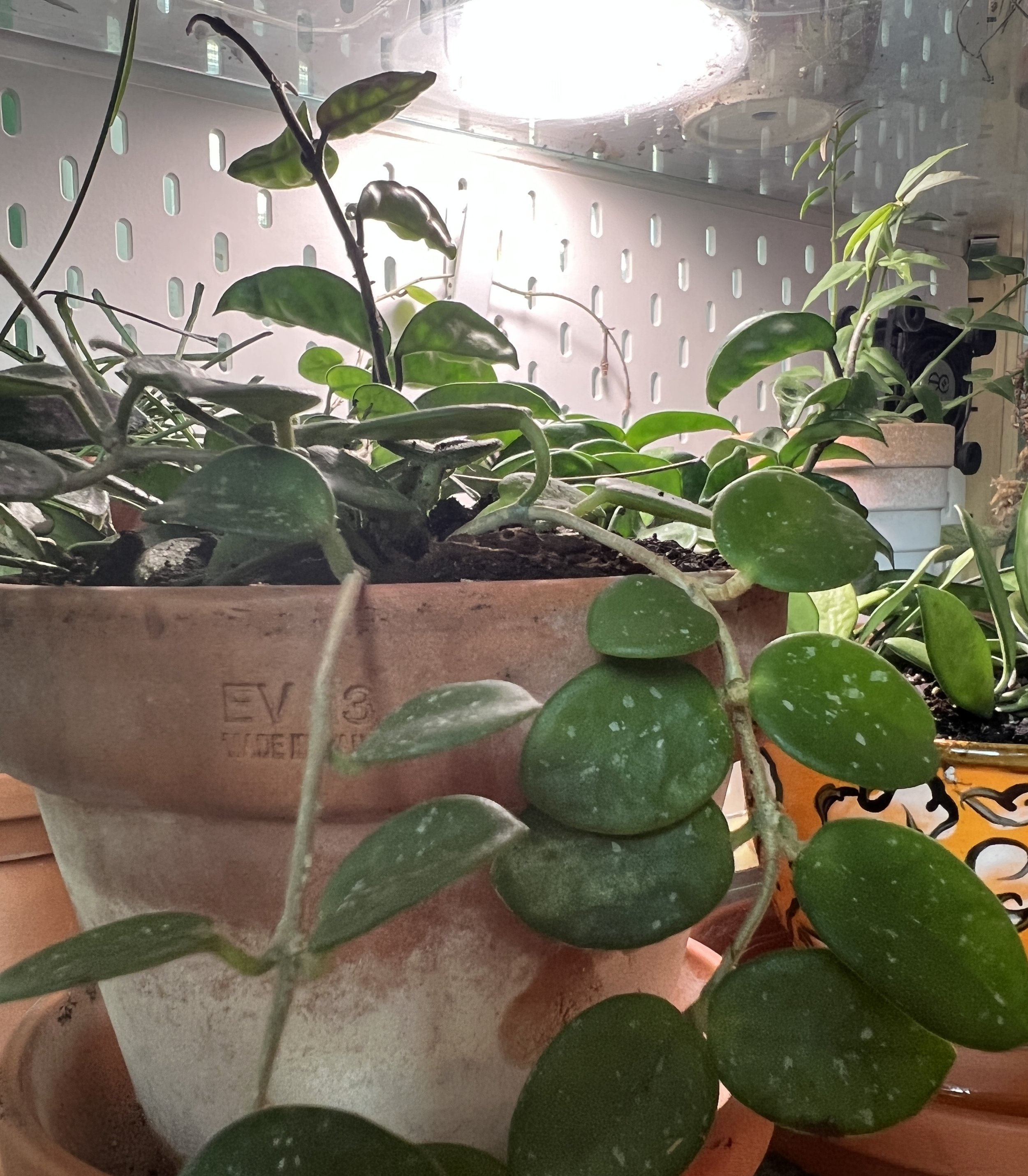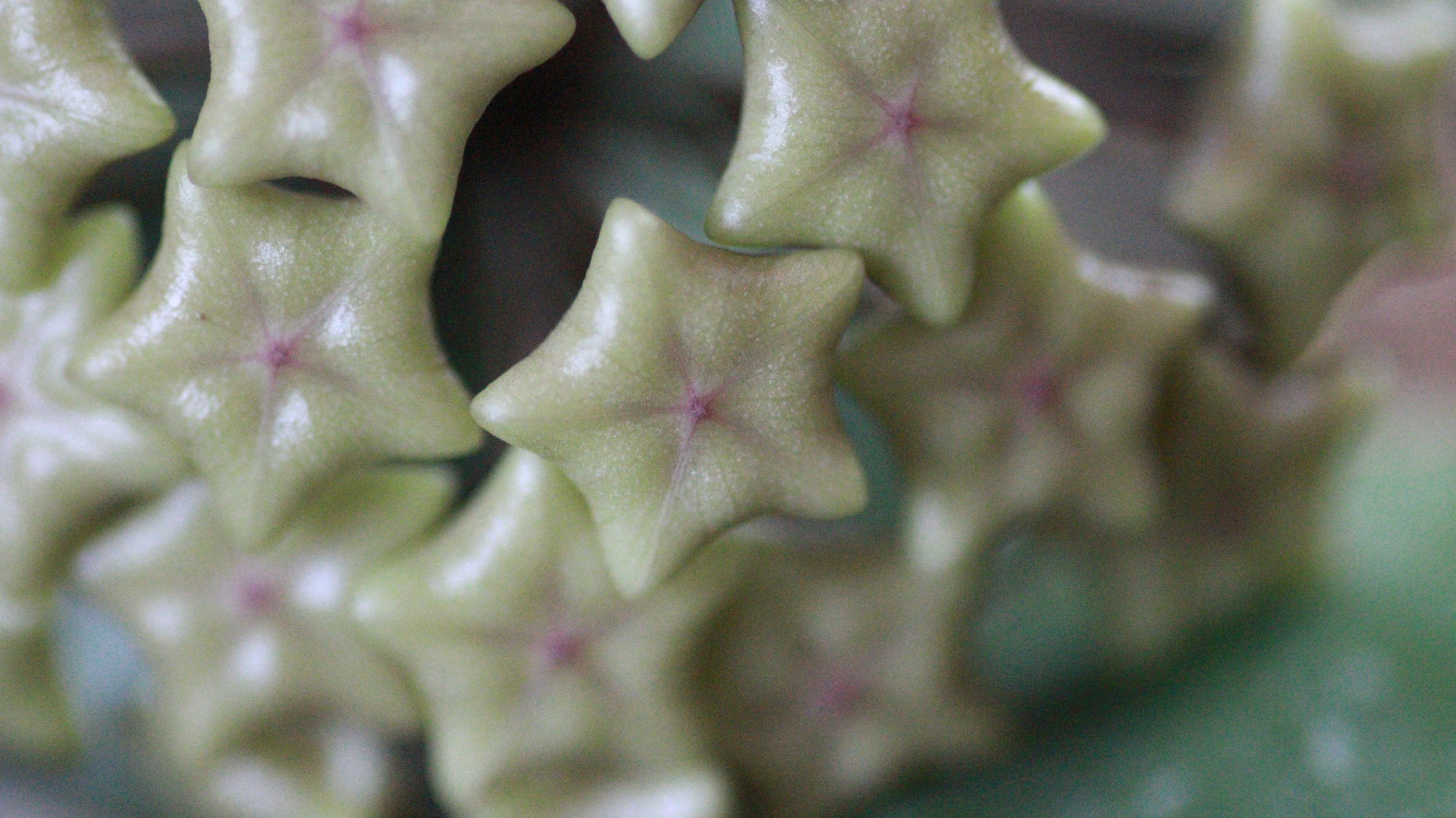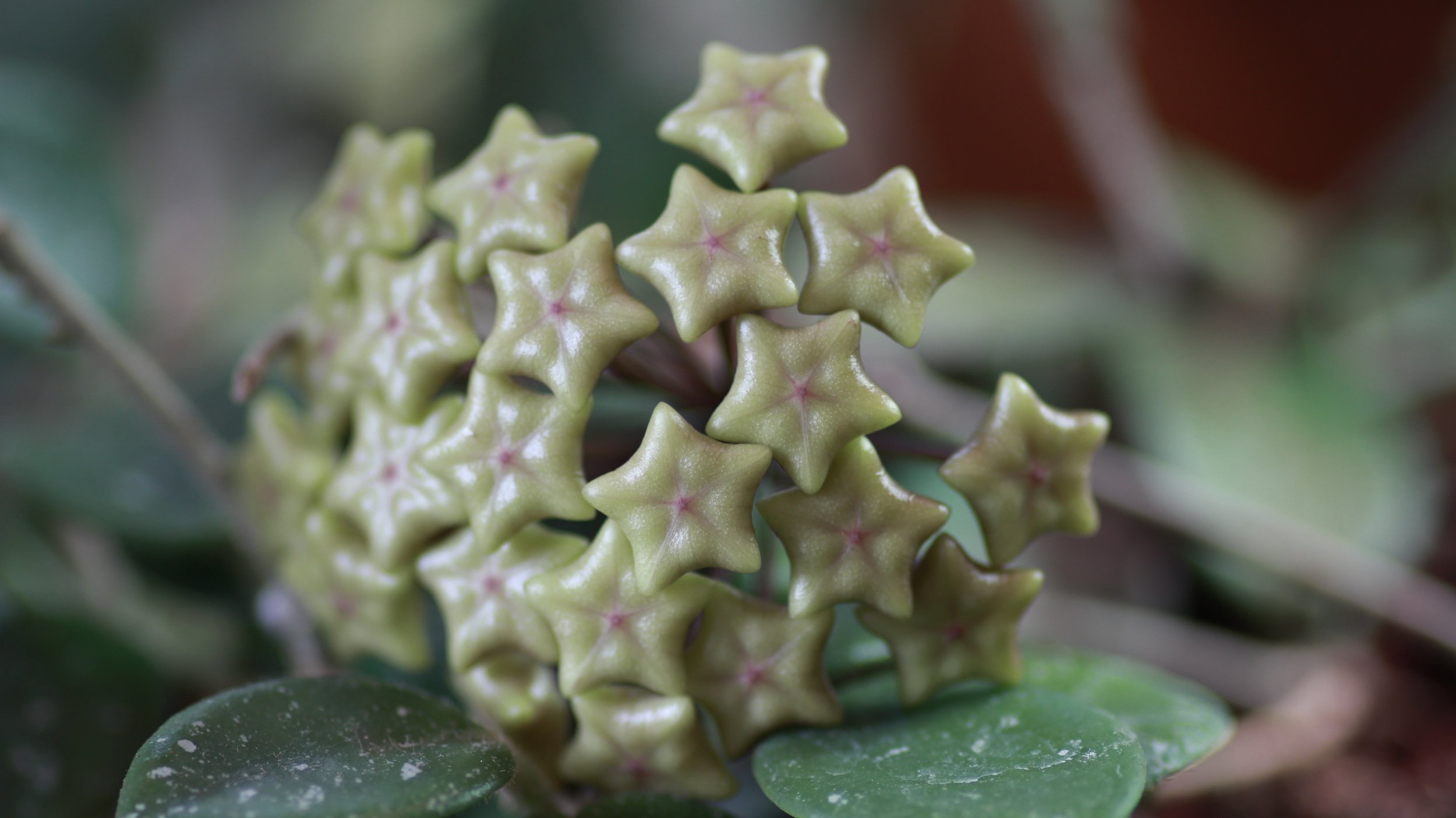Plant Profile: Hoya cv. ‘Mathilde’
My fascination with Hoya ‘Mathilde’ sprung from my obsession with Hoya serpens. The little Hoya serpens gets me every time, and it’s no surprise that ‘Mathilde’ would do the same seeing as how she’s a cross between Hoya serpens X Hoya carnosa. ‘Mathilde’ is a cultivar, written as Hoya cv. mathilde or H. cv ‘Mathilde.’
I’ve grown all three plants, Hoya serpens, Hoya carnosa, and ‘Mathilde’ for years now. After a lot of ups and downs, I’ve determined that ‘Mathilde’ is neither as fussy as Hoya serpens, or as laid-back as Hoya carnosa. While my carnosa plants of several varieties make my life easy, serpens keeps me on my toes with growth and blooming in fits and starts that have no real rhyme or reason. ‘Mathilde’ gave me stress for about the first year. After my Hoya serpens achieved consistent growth and blooming inside of one of my greenhouse cabinets, I decided to move ‘Mathilde’ there to see if she might thrive as well. To be fair, she wasn’t failing out in the open air of my home, and I don’t see ‘Mathilde’ as a plant that requires the sustained conditions of a greenhouse cabinet. This plant, in my experience, can thrive in most reasonable household conditions. I moved her because she wasn’t doing anything at all, and I wanted her to be happy. Don’t get me wrong, I don’t expect Hoya blooms to be exploding left and right like fireworks. I know that to grow Hoyas is to play the long game as an indoor gardener. Immediate gratification is infrequent at best, but it makes the plant victories so much sweeter. Here, I’ll share with you what I’ve learned from my years of growing Hoya ‘Mathilde.’
Because I have to: This is just my experience with growing this or any plant. I’m sharing my experiences as a houseplant lover from my desk in the Midwest US. The tools I’ve used for success might not be the keys to your success if you’re in a completely different environment with a completely different ‘Mathilde.’ I certainly don’t know it all, I just have a burning love for the houseplant game, and I love to talk. Which reminds me, if you want to skip to the bullet point summation of this article, click here. Don’t forget to check out more photos at the end.
Purchasing ‘Mathilde’
I began with an iffy plant right out of the gate, and that could be the reason for my initial year of troubles. The plant had been rooted shortly before shipping, and it didn’t handle the journey well. An already fragile plant with fresh roots was subjected to an experience it would’ve liked to forget. Unfortunately, the plant didn’t forget it’s rocky beginnings with me. With consistent care (more on that later), my plant stabilized and I no longer felt like I was on a constant death watch.
Purchasing a quality plant is easier said than done. I could only find ‘Mathilde’ online, which means days surviving in a dark shipping box. This is certainly less than ideal, but those of us with plant passions do as we must. Since starting with a quality plant is key, I really wanted to begin anew after my sketchy plant experience with my first ‘Mathilde.' I ended up purchasing some amazing ‘Mathilde’ plants from Logee’s and adding those to my existing plant to create a fuller, healthier pot. The experience moved uphill from there.
Environment
‘Mathilde’ bloomed for the first time in the early summer of 2022, as seen in the photo above. I attribute this almost entirely to the environment in which she currently lives, inside a greenhouse cabinet. As I said, I do believe that ‘Mathilde’ can grow happily in average household conditions, but that’s not where I keep her for the time being. I believe that she’d need a prime window spot to bloom outside the controlled conditions within the cabinet. That might be easy enough to come by in many households, but space is tight around here. This cabinet, for the record, is the same one that sustains my Hoya serpens. See below.
You’ll find ‘Mathilde’ in the bottom left corner of the cabinet. On a typical summer day, the cabinet will be warm. It averages in the high 70s. There’s a breeze on each shelf from the fans, which provides the necessary air flow that the plants need to prevent mold or soggy potting mix. There is no humidifier inside the cabinet. The one outside is able to provide humidity to the room and the cabinet. I can definitely see it on the meter when I forget to fill the humidifier. The average humidity is 60%-80% this time of year. The light is very consistent. Each shelf has a light, and they’re set for around 12 hours per day on automatic timers. ‘Mathilde’ is checked at least once a week, although it often ends up being more frequently.
This past spring, ‘Mathilde’ began having a major growth spurt in one of her vines. It began growing closer and closer to the light. Eventually, that vine grew a peduncle which immediately bloomed. This was about a month ago, so I’m eager to see if she will set up blooms again this summer. Spoiler alert: as I write this post that I began a couple of weeks ago, new blooms are setting up!
The plant pot sits in light that measures about 4 out of 10 on my light meter.
However, the vine with the bloom hovers in an area where the light measures closer to 6 out of 10 on the light meter.
I liken this to a wild epiphytic plant growing in the direction that’s most beneficial for light, water, and nutrients. In this case, we’re just speaking on light. ‘Mathilde’ sought the light, literally, and shortly thereafter she bloomed for the first time.
Potting
I grow ‘Mathilde’ in terracotta with a drainage tray. I like the breathability of the “baked earth” pots, and the drainage tray helps me ensure that she’s getting all the water she needs, while also helping me keep an eye on how her root system is doing. When the water begins filling the tray faster over time, I know that I’ve either lost potting mix over time, or the root system of the plant has grown substantially. In either case, this tells me that I need to have a look at the roots of the plant to ensure they’re getting the water, potting mix, and nutrients that they need to support the plant. This plant just had a total refresh. Every year or two (depending on general health and wellness of the plant) I like to check inside the pot and evaluate the root systems of each plant. They’re either repotted into the next size up, or simply get a fresh batch of potting mix to replenish nutrients that have been lost from the potting mix over time. I use potting mix that I blend myself specifically for my Hoyas and other like-minded plants. More info here.
Nourishment
In the wild, a Hoya would be living as an epiphyte. She’d be nestled in a tree crotch where the rain water washes over her and brings hydration along with nutrients that she can absorb. Earthworm castings are a great way to bring the outdoors to your houseplant. I add them to all of my potting mixes. As an alternative, I use Miracle-gro orchid spray fertilizer for many of my Hoyas. Hoya ‘Mathilde’ has responded well to this method. The earthworm castings are used as a top dressing yearly. I use the spray fertilizer whenever I remember. You can learn more about that here.
Water
I would usually water ‘Mathilde’ about every ten days or so. I don’t put her or any other plant on a schedule. However, this summer I’ve noticed that my plants have been extra thirsty. I’ve been watering weekly, closer to every seven days. I always check the leaves of my Hoya plants to see if they’re soft, hard, or in the middle. If they’re soft, I water thoroughly. If they’re firm, I leave them alone. Anything in between gets a mental note to check back in a couple of days.
The ‘Chouke’ Situation
‘Mathilde’ has a sister! ‘Chouke’ is also a cross between Hoya carnosa and Hoya serpens. I have found ‘Chouke’ much harder to find for purchase. I did finally find a plant, and I have been growing her for slightly over a year now. We’re still in the “getting to know you” stage of our relationship, and I have yet to figure out exactly what makes her tick. I can say that it’s not (for me, in my growing conditions) the same recipe for care as ‘Mathilde.’
While the leaves on ‘Mathilde’ are mostly round, ‘Chouke’ has leaves that come to a point. My plant does not have any splash like her sister. They are about the same size as ‘Mathilde,’ around the size of a Nickel. On my particular plant, they’re less smooth and definitely thinner. I’ve found the leaves on all of the ‘Mathilde’ plants I’ve owned to be rather thick after a thorough watering.
Below you will see Hoya serpens in the top circle, ‘Chouke’ in the left circle, and ‘Mathilde’ in the right circle.
And, for perspective, the plants without the magnification circles.
‘Chouke’ a bit closer up.
The Quick Facts on ‘Mathilde’ Growth and Blooming:
Give her light. If you’re in average household conditions, an East or West window would be great.
Let her dry out between waterings. Check 2-4 leaves on the plant to determine if they’re soft, firm, or in the middle. If they’re soft, give her a thorough watering through the drainage hole. Sometimes I let the water sit for around 15-20 minutes to ensure she’s been able to suck up all the water she needs.
Humidity is a nice bonus, but she doesn’t need anything crazy. Average households run around 30-40% humidity depending on the geographical location and the season. ‘Mathilde’ isn’t a Hoya that requires high humidity because her thick, juicy leaves don’t transpire quite like a thinner leafed Hoya. However, it won’t hurt if you give her more, as she’d be getting more outdoors. For more information on building your own greenhouse cabinets, check here and here.
A water soluble fertilizer or spray fertilizer is suitable once a month in the growing season. It’s also a bonus to pot her with some earthworm castings to boost nutrient content of the potting mix.
Terracotta is my personal choice for this and other Hoya plants. The breathability of the “baked earth” material mimics most closely what ‘Mathilde’ might find in her home environment. Her roots still need air, and the terracotta is a great way to safeguard from overwatering. Choose a pot about an inch or so larger than her root ball.
Choose the right potting mix. You can mix your own to save money and so you have the ingredients on hand to make custom mixes based on the plant you’re potting. It’s also a huge key to protecting your plants if you’re likely to overwater. The chunkier the mix, the faster it’s going to drain and dry. Dense potting mixes will be wet for longer. You can learn more about the correct ingredients and ratios for most Hoyas here.
Patience. This plant has had her ups and downs. We all have that one plant that “shouldn’t” be difficult, but somehow it is. ‘Mathilde’ has had me on death watch a couple of times, but patience won out. Or at least it seems to be for now…
Materials:
I often get asked specific questions about what products I use in my cabinets. I do not have partnerships or affiliate links. I share the products I use because I like them and they help me care for my plants. Currently inside this cabinet, ‘Mathilde’ grows under a GE grow light “BR30 Seeds and Greens.” The bulb is inside a simple clamp light from the hardware store. I removed the clamp and placed the light on the glass shelf above ‘Mathilde’ and her shelf mates.
I use AC infinity multifan S5.
The bottom shelf has a heat pad for seedlings, which helps the temperature within the entire cabinet stay warm and consistent.








